
Nothing says “end of summer” like fading tans, empty propane tanks, sunscreen aversion, and… a fresh quality update. Yes, here we go again…
As I mentioned in my post about the May 17, 2017 update, Google seems to be pushing quality updates almost monthly now (refreshing its quality algorithms). That’s great if you are looking to recover, but tough if you’re in the gray area of quality and susceptible to being hit. Over the past several months, we have seen updates on May 17, June 25, July 10, and now August 19. Google has been busy.
Barry Schwartz was the first to report the August 19 update, but it wasn’t long before many started chiming in. I began digging into the dataset I have access to across sites, categories, and countries to better understand the impact.
In addition to reviewing the data I have access to, my inbox lit up with companies reaching out after seeing dips and surges. And then I had other people on Twitter, Facebook, and LinkedIn message me about the impact they were seeing. So, it was clear that Google pushed another major update on 8/19, with either testing or a different update on 8/14 (more about that soon).
In this post, I’ll provide examples of the impact, explain the connection to previous quality updates, touch on impact I saw on 8/14 for several sites, explain what I’m seeing on sites that were negatively impacted, and then highlight some cases of surges and/or recovery.
There’s a lot to cover, so let’s jump in.
Examples of Impact (There Are Many)
First, I wanted to provide some examples of the volatility I’m seeing across sites, categories, and countries. Notice the swings in visibility when the August 19 quality update rolls out.
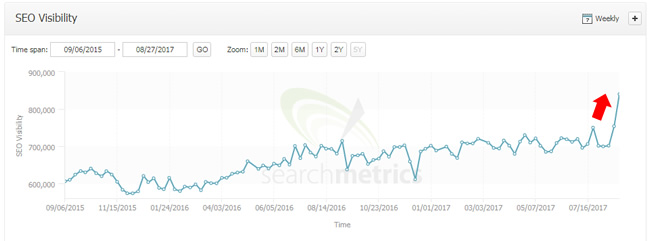
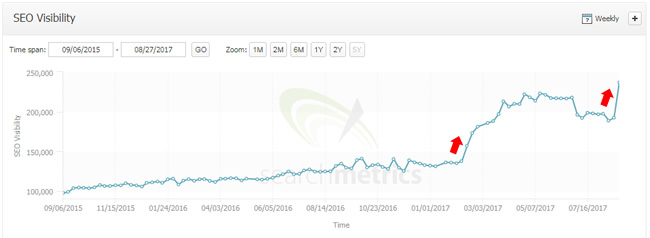

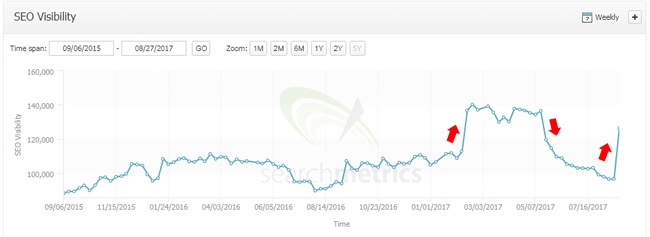
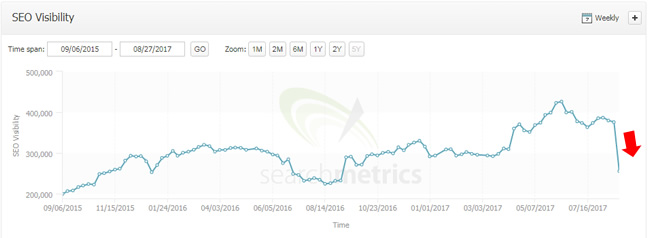
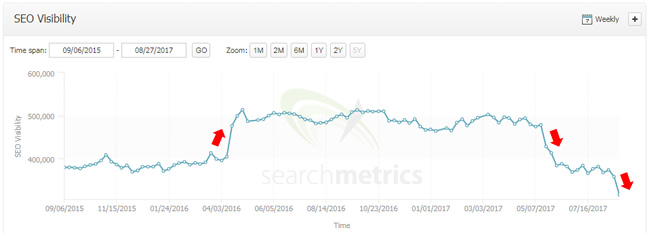

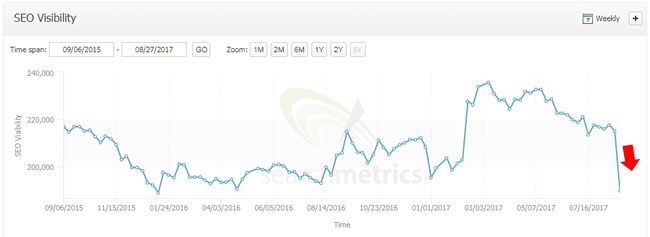
And there are many more examples of volatility.
Connection to previous quality updates.
When a major update rolls out, it’s always interesting to see if there was a connection to previous quality updates. For example, sites surging or dropping that have been previously hit by other quality updates. You could definitely see that too, which is one reason to believe this was another quality update. The other reasons relate to what I’m seeing on sites negatively impacted, while knowing what sites worked on that are seeing recovery. Also worth noting is that some sites impacted by Fred saw changes. Many have been struggling after being hit by that update, so it’s an interesting side note.
Here is an example of a site seeing impact during several quality updates:
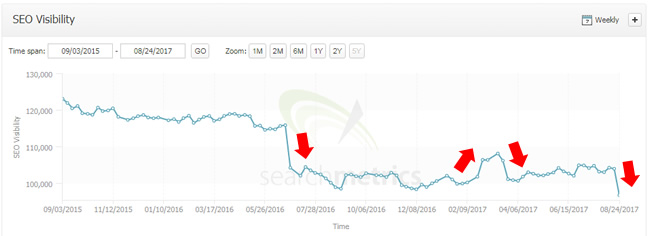
The 8/14 Connection: Testing, or another update?
An interesting observation I made while reviewing sites that were impacted was additional movement starting on 8/14. This wasn’t just one or two sites, but a number of sites seeing movement on 8/19. That had me wonder if this was this a test of the 8/19 quality update, or a completely different algorithm update that was rolled out prior to 8/19?
That’s really hard to say, but I haven’t seen any sites that were impacted on 8/14 that didn’t see additional impact on 8/19 (either reversing course or seeing more negative/positive impact). That makes me believe the two are connected (and could have been just a test of the update). Just an interesting side note.
Here is an example of impact starting on 8/14, then reversing:

And Alan Bleiweiss shared an interesting case on Twitter, where a site he has access to saw a drop starting on 8/14, only to bounce back a few days later. Between what I’m seeing, and cases like what Alan shared, something happened on 8/14. That’s for sure.

Negative Impact: What I’m Seeing Across Sites That Dropped
As usual, I dug into sites seeing negative impact to better understand content quality, UX barriers, monetization strategy, advertising setup, technical SEO, and more. As I’ve written about before, there’s never just one smoking gun when you are hit by a quality update. Instead, it’s typically a battery of smoking guns. During my travels, I saw a number of quality problems across categories.
And again, I’m not saying each of these is 100% a factor. Instead, it could be the overall negative user experience from the combination of these factors. Google is trying to make its users happy, so it’s important to highlight any issues that could detract from the user experience (or destroy it).
Category (Tag-like) Pages Ranking Well
I came across several sites that dropped that had many category pages ranking. These are tag-like pages with just a listing of links leading to more content. Checking queries leading to those pages revealed the category pages often could not meet or exceed user expectations (at all). The pages sometimes had massive amounts of supplementary content without much main content. That led to a confusing experience for users.
For example, users were being driven to pages that couldn’t answer their question, and that hammered them with supplementary content (making the experience even more confusing). Not good. Those pages dropped in rankings (and sometimes heavily).
Aggressive, Disruptive, and Deceptive Advertising
Ah, we meet again my friend. I’ve written heavily about how dangerous aggressive, disruptive, and deceptive advertising could be from a quality update standpoint. And I saw many examples of this while analyzing the August 19 algorithm update.
It never ceases to amaze me how some sites absolutely hammer their visitors, attempt to trick them into clicking ads, provide horrible UX barriers, and almost give them a seizure with crazy ads running across their pages.
And let’s not forget full screen ads, advertising elements that push the main content down the screen, annoying popups, and more. I also saw the weaving of ads into main content many times on sites impacted by the 8/19 update. And some of them even tricked me into clicking them while browsing the sites. That’s never a good sign, since I’m neck deep in this and can typically pick up deceptive ads.
An example of a full-screen ad from a site negatively impacted by a quality update. Think about how disruptive this is for users:
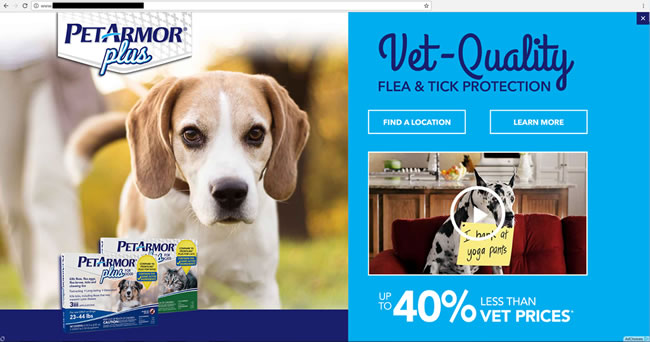
One site lost 40-50% of its traffic overnight and it took me about thirty seconds to see the aggressive advertising situation across the entire site.
You need to be keenly aware of this if you run advertising on your site. Do not hammer your users, try to deceive them, drive them off the site when they aren’t expecting that, provide full screen ads as users are trying to read your content, and more. If you do, then don’t be surprised if you wake up one morning to lower rankings and less traffic. Again, I can’t tell you how many times I have seen this happen. Beware.
The Margarine of Content, Just Not Good Enough
I saw a number of examples of pages with decent content, but that dropped during the August 19 update. When checking the competition, you could clearly see higher quality content across most of the urls that now took up the top ten listings. I saw this a number of times during my travels.
This was basically Google’s quality algorithms reevaluating the site and finding that it just wasn’t as high quality as they thought it was previously. Google’s John Mueller has explained this several times before. If that’s the case, then work hard to improve the content on your site. This is one of the cases where there isn’t one thing to change… you just need to improve your content overall.
Here is John explaining that in a Google webmaster hangout:

Flash and Broken UIs:
While analyzing sites negatively impacted by the 8/19 update, I kept coming across sites with broken UI elements, including using flash elements on the page. Those flash elements will not play on mobile and they are also disabled by default in Chrome.
The user experience was absolutely negatively impacted by not seeing the content, and by seeing broken elements. I’ve seen broken UIs before while analyzing previous quality updates, and that could simply relate to unhappy users. For example, users bolting from those sites, and Google picking up the low dwell time in aggregate.
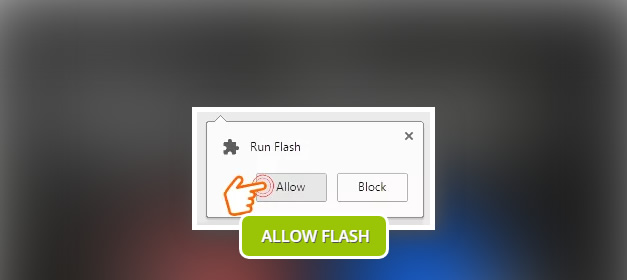
Low relevance based on query. Panda-like.
I’ve mentioned this before when writing about algorithm updates, but there are times sites drop that were ranking prominently for queries they had no right ranking for. And remember, this is exactly how Google now explains Panda. Both Gary Illyes and John Muller have explained Panda this way, especially since it became part of Google’s core ranking algorithm.
For example, Gary has explained that Panda isn’t a penalty. It will adjust rankings for sites that are ranking prominently for queries they can’t answer. I saw that several times during my analysis of the August 19 quality update.
Here’s a video of Gary explaining this:

Now that Panda is running continuously, it’s hard to say if Panda is refreshed at the same time that Google’s other quality algorithms are refreshed, or if something else happened. And we’ll never have that answer (based on how Panda rolls out now). But this is worth nothing so you can review the queries leading to your site, your content, and make sure they meet or exceed user expectations. Always look to identify those problematic areas… and close the gaps.
Thin Content Surrounded By Ads
I mentioned aggressive advertising earlier, but there are times aggressive ads are combined with thin content. That’s a dangerous combination to say the least. I saw that several times when checking sites negatively impacted by the 8/19 update. It’s critically important you don’t suffer from this quality double whammy. Beware.
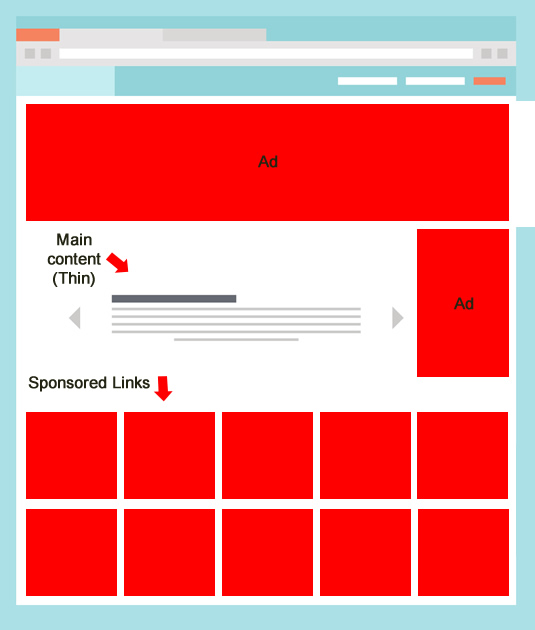
Examples of Sites Surging and/or Recovering
On the flip side, there were many sites that surged during the 8/19 update. And it was great to see a number of companies that have been working hard to recover see increases. These are companies that had been impacted by previous quality updates. I’ll touch on a few cases below.
Nuclear Option + Strong Content Development Strategy
One company that has seen continual increases during the past several quality updates was once in a very different situation. This is a site that had been impacted by multiple algorithm updates in the past, including Panda, Penguin, and Quality Updates. They contacted me several years ago and have made great strides since then.
That included revamping the entire site, nuking low quality content, improving technical SEO across the board, enhancing their mobile experience, and the latest significant change relates to content. They finally crafted a strong content development plan based on understanding prospective customer pain points.
So they are writing killer blog posts that address those needs, answer those questions, and thoroughly cover topics. That includes video when needed. And that is paying off big-time. They are up 46% since the May 17 update. That’s huge for them and is directly impacting their bottom line. Those new blog posts are driving more people to actually buy from them. That’s a great example of how a killer content strategy can pay off (in multiple ways). Traffic, revenue, trust, etc.

No UX barriers, helpful comments
Another site that saw a healthy increase during the 8/19 update moved to a clean content approach (without weaving ads throughout the content). So instead of breaking up that content many times with annoying and disruptive ads, users could read the entire content without coming across those barriers.
In addition, each of the articles contains valuable and helpful comments. The comments are moderated heavily and add a lot of value to the page. Remember, Google’s John Mueller has explained several times that the comments help comprise the content on the page. Therefore, high quality comments can impact the overall quality of the page (and site when taken in aggregate).
Here is John Mueller explaining that comments and UGC help make up the content on the page:

Industry leader falls, and gets back up
I’ve been helping a site that drives a lot of traffic from Google each day. I’m talking about over a million clicks per day. But they have faltered several times in the past at the hands of quality updates. Even though they are an industry leader, the site is complex, and has many pitfalls.
The crawl analysis and audit I performed yielded several deliverables filled with problems to fix. That was across categories like content, advertising, tech SEO, and more. They are now a few months out from making key changes across the site and have seen a noticeable increase in visibility (especially with the August update). This is a great example of a site tired of the gray area and making a concerted effort to increase quality over the long-term. And it’s paying off.
Here’s a snapshot of some of the rankings increases since the August 19 update:
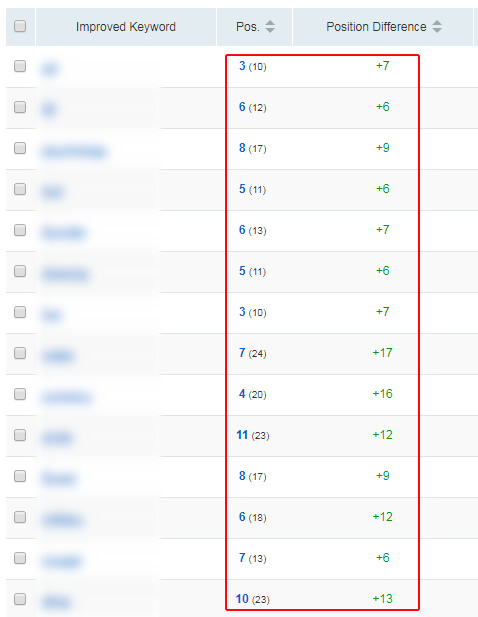
Collateral Benefit (Algo mistakes)
We often discuss collateral damage when referring to algorithm updates, but there can also be collateral benefit. That’s when a site surges when it really shouldn’t. I saw that a few times during my travels analyzing the August 19 update. That’s my opinion, of course.
One site surged like mad, but it ends up that mobile users are the only ones seeing the true content. Desktop users are redirected to a less-than-optimal experience.
But here’s the rub. They are cloaking. So Googlebot is seeing what the mobile users see and never seeing the redirect to a less-than-optimal page and experience.
Now, I started to think that maybe the site had been switched to the mobile-first index, but that doesn’t seem to be the case. I can check when the site believes it’s a mobile visit versus desktop and the indexed page shows “desktop”. The site absolutely surged during the 8/19 update.
Hit by the 8/19 update? Make significant changes, avoid band-aids.
If you’ve been impacted by the 8/19 update, then you need to significantly increase quality overall, and for the long-term. Google’s John Mueller has explained this several times when being asked about quality updates. Check those videos out to learn more.
And if you’ve read any of my previous posts about Google’s quality updates, then you know I’ve provided very similar advice. You need to hunt down all potential quality problems and rectify them as quickly as you can. This can definitely take time to audit, analyze, identify, fix, test, and roll out, but that’s exactly what you need to do.
Perform a thorough crawl analysis and audit of your site, surface UX barriers, thin content, and low quality content. Then handle that correctly by either improving the content, nuking it (404), or noindexing it. And absolutely review your advertising setup. Do not provide aggressive, disruptive, or deceptive advertising. Again, I cannot tell you how many times I have seen this across sites that have been negatively impacted by Google’s quality updates. It’s sometimes hard to take a step back and look at site quality overall, but that’s exactly what you need to do. Again, there’s typically not one smoking gun… there’s usually a battery of smoking guns affecting a site.
Summary – Fall Is Coming, Expect More Quality Updates
I explained earlier that Google seems to be pushing quality updates at a higher frequency than ever before (refreshing its quality algorithms nearly monthly now). So if you’ve been impacted by the August 19 update, then start working on your site now. Surface all quality problems and handle correctly. Google will need to see significant changes in quality, and over the long-term in order for you to see recovery.
Good luck.
GG

Great summary Glenn. I really do think that most of the sites hit by these latest quality updates are cases where Google is able to recognize that competitors truly are doing a better job at serving users.
Gone are the days where we could say, “Oh, Google did this and now you just have to do this.” In almost every site that I examine now that has drops associated with core quality updates, the answer is a significant overhaul in not only technical issues but also in the amount of value that the site is providing users.
Right, and it’s why I always say there’s never one smoking gun. It’s typically a battery of smoking guns. And that can include content quality problems, UX barriers, aggressive and deceptive ads, etc. That’s also why it unfortunately takes a lot of work remediation-wise to recover, surge, etc. And on top of that, Google needs to see those significant changes over the long-term. There aren’t many sites that can turn it around quickly and see big changes. It takes time and significant improvement.
Hi Glenn,
Thanks for a thorough explanation and I read all your previous posts about Fred and phantom. It really opens my eyes. We’ve been hit hard and keep tanking. Actually, I see a drop in my website traffic on 18 March, since then traffic is just kept tanking whenever Google refreshed its algorithm. You said ads weaving into the content can be misleading and disruptive. I actually showing one ad just after the paragraph no. 1 and I also labeled that AdSense ad unit as “advertisement”. Can this be a problem that I am showing the ad in the middle of the content?
Also, when I started the website in January, 2016 I submitted some of my posts to a website (here is the website name tutorialized .com) to gain some traffic and exposure. The website where I submitted the article is actually outsourced other websites and you can read the article of any website which is submitted there without visiting that website like StumbleUpon. I’ve submitted 20 posts there and now they have 20 posts same as mine. Since the site is outsourcing my website, as a result, I got 500 links (GSC showing) from this site to every article of my website. It is like I am pointing links to my own website (navigation links, popular post links on the sidebar, related post links at the end of the every article are being counted by Google). Can this be a problem? All of your thoughts are welcome.
Thanks,
Bunty
Hi Bunty. I’m sorry to hear you are seeing negative impact with each quality update. That’s not unusual unless significant changes are made. I haven’t seen your ad setup, so it’s hard for me to say. If it’s just one ad and it’s not intrusive, then it’s probably ok. That said, if it’s pushing down the main content, disruptive, etc., then it definitely can be causing problems. Hard to say since I haven’t seen it.
Regarding the second question, that doesn’t sound like a great situation. I’m not familiar with their service, but you need to be careful when syndicating your content. Those articles need to be handled properly. For example, they could contain rel canonical pointing to your original article, they could be noindexed on sites consuming the syndicated article, etc. But I wouldn’t just blast your articles out to many different sites. John Mueller actually covered this several times in webmaster hangout videos. I hope that helps.
Thanks for the reply Glenn. If you have a time I can send you the link to my web site’s post so you can see how the ad is displaying. Also, I can send the example of my syndicated content. I know you are busy but if you just give your thought on that then it would be great. Our traffic is just kept tanking with every update since March. No positive movement even a little bit. Let me know if you want to take a look and I’ll send you the link right your way.
Sure, can you email me via my contact page?
Have observed a massive drop in traffic since this update…spending thousands in building a site with white hat seo over 5 years and then being suddenly penalised. 5 years of allowing google to advertise crappy Adsense adverts on my site and getting chump change in return-you force my hand and will be looking to go black hat. Big thumbs down for google ..Grrrr not happy chappy
I’m sorry to hear that Mark. Have you been impacted by previous quality updates? How about any old-school Panda updates (prior to 4.2)? It’s hard to say what’s going on without knowing the site, but definitely read my previous posts about quality updates. There may be some findings in those posts that could help you.
Hi Glenn, Thanks for this amazing information, its surely gonna help other webmasters deeply understand the behavior and effects of these quality updates. I have been through all your previous posts and must say that your posts have always been an eye-opener for me. I would like to share my experience or case study with you. My website is of coupons & cashback niche, we got a hit with the May 18 quality update and we lost almost 40-50% of the organic traffic. After going through your article on May 18 update i figured out that cross selling pop ups are affecting the user experience of my website. As those popups were covering the main content of the page. I removed all the pop ups and have recently changed the design of the website. But i still have some leave intent popups on few pages where we can give users a better deal. Those pop up’s also cover the main content and they are only triggered to the users who are leaving my website. The ranking of those pages are decreasing day by day and i just wanna know if the popups could be the only reason for it ?
Thanks Ankit. I’m glad my posts have been helpful. And I’m sorry to hear you were negatively impacted by the May 17 update. It was a big one.
Regarding your questions, it’s hard to say without checking out the site. But, based on what you wrote, it sounds like you are employing aggressive ads/UX barriers. I would definitely try to avoid doing that. I’ve seen situations like that many times while analyzing sites negatively impacted by quality updates.
Also, and this is important, there’s typically not one smoking gun with quality updates. It’s typically a battery of them (you’ve probably seen me write this many times). So I would look at the site from an overall quality perspective, which includes content quality, UX barriers, advertising setup, technical SEO, etc. And once you make changes, Google will need to see those changes over the long-term. It can take months to see increases after making important changes like that. I hope that helps.
Thanks for your feedback Glenn, if you could just have a look at our new design and share your feedback it will be highly appreciated!!!
Hi Glenn,
Yet another great post, thank you!
Regarding your comment here in your summary:
“Google will need to see significant changes in quality, and over the long-term in order for you to see recovery.”
From your datasets, how long are you seeing as “long-term” on average?
For arguments sake – if you were to implement major quality fixes on 1st Jan, would you expect Google to want to see these changes last (as well as continued high quality content production, link accruals etc) for at least 3 months? 6 months? before any positive reflections are made in an update?
Would love to see what you’re finding in your data.
Further, when Google rolls out a quality update, are you seeing that the update is based upon data from several months back or as recent as a few days/weeks before?
In other words, if an update rolled out on June 1st, could that be based on data from up to May 31st or a lot further before? I’ve always found this exceptionally hard to test.
Thanks again for the super helpful and actionable content.
Hi Alex. I’ve actually mentioned time-to-recovery a number of times in my posts about Panda, Quality Updates, etc. It’s usually a few months at least before you can start to see recovery. That’s not including tremors from algo updates that cause sites to quickly revert. I’ve covered tremors several times in my posts as well (and John Mueller’s comments about them).
I believe the quickest recovery I saw from a quality update was ~2.5 months. And that’s pretty quick to be honest… And it makes sense. Site owners need to audit, surface, fix, test, and then release major changes. Then Google needs to recrawl all of the changes and then see those changes in place over the long-term. And from a user engagement standpoint, Google needs to understand how the changes impact users (again, over time).
It’s why I tell companies impacted by major algorithm updates to work like you’re not impacted by an algorithm update. Work hard to significantly increase quality, cut down on low quality content, fix UX barriers, improve their ad setup, continually publish high quality content, and build links naturally over time. That’s how they can get out of the gray area and stay out.
Regarding the data Google is using, it’s hard to say how far it goes back. I wouldn’t really think that way, though. I would just work hard to fix current problems on the site and then drive forward based on what I explained in the paragraph above. I hope that helps.
We had a site that had a huge drop in rankings. The only major change this summer was a Facebook Ad campaign that another group was running. Starting June 10, we were getting a high number of clicks from Facebook, but the bounce rate was HIGH. Overall, it upped the monthly bounce rate from 59% to 82% because the clicks from the Facebook ad is running at a 90% bounce rate. Is it possible that Google sees this jump in bounce rate as an indication of poor quality content and whacking our rankings?
Hi Craig. I’m sorry to hear you saw a big drop in rankings. The 8/19 update was a big one. That said, Google does not take other traffic sources into account when determining rankings. And Google’s John Mueller has explained many times that they don’t use Google Analytics data at all. I would read through all of my posts about Google’s quality updates and then analyze your own site objectively. In my experience, there’s typically a number of core problems on sites that have been impacted.
One last note about bounce rate. There’s a difference between bounce rate and dwell time. And I personally do believe *low* dwell time is used by Google in aggregate. That’s when someone searches Google, clicks to a site, and returns to the search results quickly. In aggregate, low dwell time is a clear signal that users are not finding what they want. But again, that’s from the Google search results and not from third party websites like Facebook, Twitter, other referrals, etc. I hope that helps.
Great example nice summary Thanks for share such great information
Hi Glenn, I’m a small business owner who’s livelihood depends on our ecommerce sales. We’ve seen a 77% drop in site traffic since this update and a 50% drop in sales after showing consistent growth for 7 years. We don’t advertise on the website. I’m so confused and frankly petrified that my business is going to deteriorate…I won’t be able to continue creating jobs and thriving if I cannot fix this problem. Where do I start?
Hi Holly. I’m sorry to hear you have been negatively impacted by the update. It was a big one and you’re not alone. Have you read all of my posts about Google’s quality updates? I would go through all of them to better understand the various issues that can be causing problems.
Also, pay particular attention to UX barriers, including popups across desktop and mobile. :)